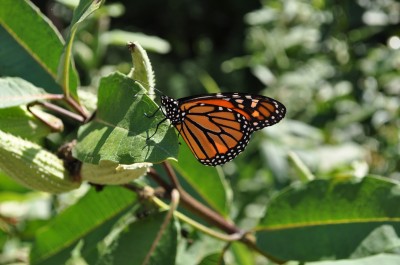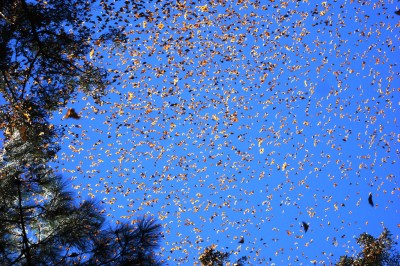If you’re like me, then you’re on the lookout for the annual migration of Monarchs through your area. Easily the most well-known of butterflies in our part of the world, the Monarch is famous for its beauty and the long trek it takes from Canada and the northern United States to its wintering grounds in Mexico and southern California.
Toward the end of the summer months in central Pennsylvania, you may be lucky enough to see a Monarch perching for a moment. That butterfly you see is beginning its migration south to the Oyamel forests in Mexico, over 2,500 miles away! To arrive before winter sets in, that butterfly may cover over 200 miles in one day. Somewhere along its journey it will meet up with tens of thousands others of its kind who will eventually arrive at their destination to rest in the final days of October. How the Monarchs know where to go remains a mystery, which adds to the wonder surrounding these beautiful insects! For 6 to 8 months the Oyamel forest’s canopy will be blanketed in orange for miles. In the spring, the next generation will begin heading north, although it will take two more generations to arrive at their northernmost point.
Unfortunately, if you have yet to spot this butterfly, it may be because the winter of 2012 saw the lowest numbers of Monarchs residing in Mexico in 20 years. The two main causes were the widespread loss of an important plant called Milkweed, which Monarchs rely on for food, and extreme climate fluctuations, including freezing temperatures and heavy rain.
The good news is: wherever there is Milkweed there will be Monarch butterflies! Adult Monarchs feed on the nectar of many flowers, but they breed only where Milkweed is found. When caterpillars eat the milky sap that gives Milkweed its common name, they build up a toxicity that makes them poisonous to birds. The plant provides the necessary food and shelter for the Monarch. So, here’s my tip for spotting this famed insect: plant a Milkweed in your garden!
Find out more about promoting Milkweed and other native plants in your own backyard here at Shaver’s Creek Environmental Center! On Saturday, August 3rd from 11:00 a.m.–1:00 p.m. we’ll be hosting a public program, Landscaping with Native Plants: Creating a Backyard Habitat. Please click here for more information on that program — and best of luck spotting Monarchs!
photo of Monarchs in El Rosario Sanctuary, Mexico by Luna sin estrellas used under Creative Commons license.


